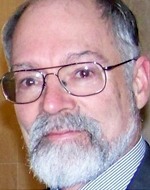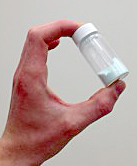 The Phase Change Matters e-mail newsletter is a weekly summary of the latest news and research on phase change materials and thermal energy storage. To subscribe, visit www.puretemp.com/subscribe. For more frequent updates, follow @puretemp on Twitter or visit the Phase Change Matters blog, www.puretemp.com/pcmatters.
The Phase Change Matters e-mail newsletter is a weekly summary of the latest news and research on phase change materials and thermal energy storage. To subscribe, visit www.puretemp.com/subscribe. For more frequent updates, follow @puretemp on Twitter or visit the Phase Change Matters blog, www.puretemp.com/pcmatters.
ACADEMIC RESEARCH
Branching out: What nature can teach us about phase change energy storage
 The melting rate of a system that allows heat to branch out in lines through a cold material can be increased by allowing the lines to evolve freely, according to new research published in the Journal of Applied Physics. The finding could help improve thermal energy storage systems that use phase change materials, which absorb and release energy as they solidify and melt.
The melting rate of a system that allows heat to branch out in lines through a cold material can be increased by allowing the lines to evolve freely, according to new research published in the Journal of Applied Physics. The finding could help improve thermal energy storage systems that use phase change materials, which absorb and release energy as they solidify and melt.
“The traditional architecture is to embed a heating and cooling coil in the phase change material, but our research shows that what happens naturally is also the best way to spread the heat into the volume: it is a dendritic structure, like a hand with many fingers,” Dr. Adrian Bejan, one of the study’s authors, explained to Phys.org. A faster melting rate indicates a more efficient transfer of thermal energy.
ENERGY
Economist: Energy efficiency is overlooked factor in measuring productivity
Greentech Media‘s latest “Energy Gang” podcast includes a segment with Skip Laitner, an economist who says we’ve been measuring energy productivity all wrong. As measured by all energy available for use, he said, the U.S. economy is running at only 15 percent efficiency.
 “Whether it’s light, whether it’s thermal energy, an industrial process, whether it’s powering up the Internet or maintaining a cold beer in the refrigerator, what is actually going on as work, to provide the cooling, to provide the heat and provide the light?” said Laitner, right. “When we [measure energy productivity] that way we find that we’re wasting more than 80 percent of that energy, and that’s nothing but a set of costs that really clamp down on the economy.”
“Whether it’s light, whether it’s thermal energy, an industrial process, whether it’s powering up the Internet or maintaining a cold beer in the refrigerator, what is actually going on as work, to provide the cooling, to provide the heat and provide the light?” said Laitner, right. “When we [measure energy productivity] that way we find that we’re wasting more than 80 percent of that energy, and that’s nothing but a set of costs that really clamp down on the economy.”
In another segment, starting at 25:30, the group talks about the Energy Storage Association‘s expo in Dallas last month. Among the takeaways: Ice-based storage and phase change material are gaining traction in the discussion of energy storage.
“Storage is everything from batteries all the way through ice storage and thermal storage units, all the way through to some of these phase change materials and other things,” said energy futurist Jigar Shah. “I was pitched a couple times by folks who had much different definitions of storage, which I thought was fascinating.”
BUILDING AND CONSTRUCTION
PCM insulation additive wins $35,000 MIT Clean Energy Prize
 CoolFlux, an insulation technology that uses phase change material to improve a building’s cooling performance, won $35,000 at last month’s MIT Clean Energy awards.
CoolFlux, an insulation technology that uses phase change material to improve a building’s cooling performance, won $35,000 at last month’s MIT Clean Energy awards.
CoolFlux was developed by graduate students Alan Ransil and Wenhao Sun in an MIT materials design challenge. The developers describe it as an additive “that improves the effectiveness of insulation without changing how those panels look, feel or could be installed.” The patent-pending technology promises to improve a building’s cooling performance by up to 40 percent.
ENERGY STORAGE
CALMAC installs ice-based storage at San Antonio high school
CALMAC has installed an ice-based energy storage system at Alamo Heights High School in San Antonio, Texas.
The system freezes water during off-peak hours, when electricity is cheaper. The ice is then used to chill five buildings on the campus during the day. CALMAC says the IceBank system has reduced peak energy use by more than 20 percent and allowed the school to expand by 40,000 square feet without the need for extra chillers.
RENEWABLES
Researchers offer ambitious plan to run U.S. economy entirely on renewables
Would it be possible to run the U.S. economy entirely on renewable energy by 2050? A team of researchers led by Dr. Mark Z. Jacobson of Stanford says yes, and lays out an ambitious and detailed state-by-state plan. Vox.com‘s David Roberts explains:
“The core of the plan is to electrify everything, including sectors that currently run partially or entirely on liquid fossil fuels. That means shifting transportation, heating/cooling, and industry to run on electric power.
“Electrifying everything produces an enormous drop in projected demand, since the energy-to-work conversion of electric motors is much more efficient than combustion motors, which lose a ton of energy to heat. So the amount of energy necessary to meet projected demand drops by a third just from the conversion.”
The study, published in Energy & Environmental Science, also sees a role for thermal energy storage, including ice, water and phase change materials, and time-of-use electricity rates that encourage off-peak energy consumption.
SOLAR

Solar Decathlon entry uses biobased PCM to reduce heating, cooling costs
California Polytechnic‘s entry in Solar Decathlon 2015 features an open design that takes advantage of the mild climate on the Pacific Coast. Team member Lisa-Marie Mueller describes INhouse as a “coastal home that is true to that climate and the very unique indoor-outdoor living that we have here year-round.”
The house, now under construction in San Luis Obispo, uses a variety of energy- and space-saving techniques:
• A 15-foot glass wall separating the living room and deck can be folded back to create an indoor-outdoor living space.
• Two-sided photovoltaic panels serve as an awning above the deck, providing shade and capturing 30 percent more energy than a single layer of PV.
• Biobased phase change material is used in the home’s ductwork to reduce heating and cooling costs.
The Solar Decathlon, sponsored by the U.S. Department of Energy, will take place Oct. 8-18 in Irvine, Calif. Entries will be judged on energy efficiency, design, affordability and consumer appeal.
RESEARCH ROUNDUP
For our full list of recent academic research, see puretemp.com/academic. Here are highlights from the past week:
From Energy:• Supercooling elimination of phase change materials (PCMs) microcapsules
From Energy and Buildings:
• Phase change material wall optimization for heating using metamodeling
From Journal of Applied Physics:
• Morphing tree structures for latent thermal energy storage
From Energy Procedia:
• Experimental Study on the Performance of RT 25 to be Used as Ambient Energy Storage
• Numerical Investigation of PCM-based Thermal Energy Storage System
• Experimental Validation of the Innovative Thermal Energy Storage Based on an Integrated System ‘Storage Tank/Steam Generator’
From Journal of Thermophysics and Heat Transfer:
• Shape-Stabilized Composite Phase-Change Materials Prepared with Stearic Acid and Active Carbon
From Applied Energy:
• Use of polyethylene glycol for the improvement of the cycling stability of bischofite as thermal energy storage material
• High thermal conductivity phase change composite with percolating carbon fiber network
From Greenstock 2015, 13th annual conference on energy storage:
• Industrial Surplus Heat Utilization through Mobile Thermal Energy Storage with Enhanced Operating Strategy
NETWORKING
Connect with PCM experts and industry leaders on LinkedIn
More than 200 of your colleagues have joined a new LinkedIn group devoted to the discussion of phase change material and thermal energy storage. The Phase Change Matters group is an interactive complement to the blog and newsletter of the same name.
You are invited to join the group and connect with PCM and TES experts from around the world. New members this week include Antoni Gil Pujol, an engineer conducting postdoctoral research at MIT, and Stephen Hamstra, president of Greensleeves LLC. Mr. Hamstra writes:
“[I] first started applying TES on large projects in the mid 1980s using good products from Calmac and BAC in traditional chilled water applications. I sold my AE firm to my partners 6 years ago and started a technology company that is focused on HVAC energy efficiency with our first priority being to improve the design and control of ground-source HVAC systems, leveraging their immense thermal storage capabilities.
“We’ve created design software to capitalize on this approach and have found that we can increase GSHP system efficiency while reducing the size of the earth heat exchanger IF we manage the ‘thermal charge’ on the earth heat exchanger. …
“I am committed to taking this technology into the next logical area of application; short term thermal energy storage via phase change materials.”
YOUR TURN
Got a question about PCMs or TES? Ask our experts
Two Entropy Solutions advisors, Dr. Mohammed Farid of the University of Auckland and Lucas B. Hyman of Goss Engineering, are ready to answer your questions about phase change material and thermal energy storage. We’ll select the best questions sent to inquiries@entropysolutionsinc.com and post the answers here each Friday.